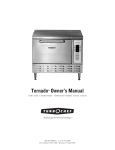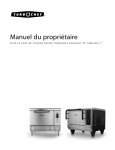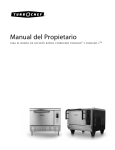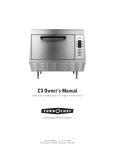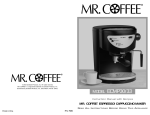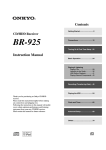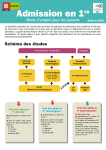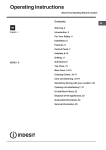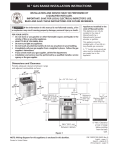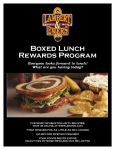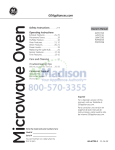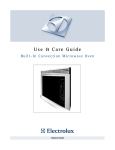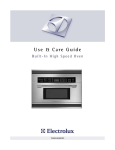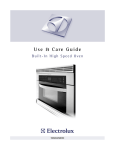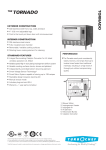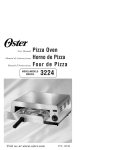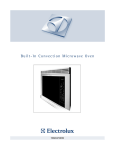Download Turbo Chef Technologies Turbochef Rapid Cook Oven Tornado 2 User's Manual
Transcript
TM Owner’s Manual for the turbochef tornado ® and tornado 2 TM rapid cook ovens m od e l se r i a l n u m b e r i n sta l l e d b y i n sta l l a ti on c h e c k e d b y s e r v i c e c e n te r n a m e / n u m b e r For service or information: wi thin no r th a me r ica ca l l Customer Service at 800.90turbo or Sales & Marketing at 866.90turbo outsi d e no r th a me r ica ca l l +1 214-379-6000 or Your Authorized Distributor TM IMPORTANT safety information - please read first warning: Improper installation, adjustment, alteration, service or maintenance can cause property damage, injury or death. Read the installation, operating and maintenance instructions thoroughly before installing or servicing this equipment. This product employs an exposed radiant heating element on the bottom of the cavity. This element is hot during operation and will remain at dangerous temperatures after the unit is switched off. never attempt to touch the element during operation or while the oven is warm. do not store or use gasoline or any other flammable vapors or liquids in the vicinity of this or any ox other appliance. The information contained in this manual is important for the proper installation, use and maintenance of this oven. Adherence to these procedures and instructions will result in satisfactory cooking results and long, trouble-free service. Please read this manual carefully and retain it for future reference. Errors— descriptive, typographic, or pictorial— are subject to correction. Specifications are subject to change without notice. Table of Contents Important Safety Instructions To Reduce the Risk of Fire in the Oven Cavity Precautions to Avoid Possible Exposure to Excessive Microwave Energy Grounding Instructions Power Supply Cord Replacement RF Interference Considerations Overview of the Tornado Specs and Dimensions Dimensions Construction Standard Features Accessories Certifications Packaging Electrical Specifications How the Technology Works The Technology Behind the Tornado i ii ii ii iii iii TM Assembly and Installation Installation Instructions Delivery and Initial Inspection Lifting the Oven Oven Location and Placement Securing Oven to Cart Double Stacking Ovens Built-In Installation Installation Near Open Heat Source Ventilation Requirements Oven Assembly Optional Installation Items Oven Restraint Kit Oven Carts Loading a Menu from a Smart Card Saving a Menu to a Smart Card Common Operating Terms Oven Operating Components Modes and States Common Cooking Terms Faults and Errors 1 2 3 4 6 7 9 9 11 11 11 12 Operating the Tornado The Control Pad Powering Up the Oven Initial Power-Up Power-Up Voltage Sensing Cooking Instructions Turning the Oven Off Editing a Food Item Changing the Edit Pin Number Editing a Food Item Changing the Idle IR Set Temperature Enabling/Disabling the Edit Mode Cooking Options - Time, Done, and Snooze The “Enter Cook Time” Screen The “Done” Screen The “Snooze” Mode Recipe Development and Cooking Tips Developing Recipes Development Methodology The Importance of Consistency Ovenables Dual-Ovenable Paper Board Baking Papers/Sheets Ceramics, Earthenware, Corningware Toughened Glass Plastics NordicWare What Not To Use Maintenance and Troubleshooting Daily Maintenance for the Tornado Tips for Prolonging Oven Life Troubleshooting Catalytic Converter Limited Warranty North America Limited Warranty International Limited Warranty 13 14 14 15 16 17 18 18 18 21 23 25 26 26 29 30 33 I ntro d u ction i IMPORTANT SAFETY INSTRUCTIONS WARNING: When operating this oven, strictly adhere to the following safety precautions to reduce the risk of burns, electric shock, fire, injury, damage to oven or property near oven, or possible exposure to excessive microwave energy. General Safety Information a Read all instructions before using this appliance. a Read and follow the specific “Precautions to be Observed to Avoid Possible Exposure to Excessive Microwave Energy” found on page ii. a This appliance must be grounded. Connect only to a properly grounded outlet. See “Grounding Instructions” on page ii. a Install or locate this appliance only in accordance with the provided installation instructions. a This appliance should be serviced by qualified service personnel only. Contact the nearest authorized service facility for examination, repair, or adjustment. a Keep the cord away from heated surfaces. a Liquids, such as water, coffee, or tea are able to be overheated beyond the boiling point without appearing to be boiling. Visible bubbling or boiling when the container is removed from the microwave oven is not always present. this could result in very hot liquid suddenly boiling over when the container is disturbed or a utensil is inserted into the liquid. a warning: The contents of feeding bottles and baby food jars must be stirred or shaken and the temperature checked before consumption, in order to avoid burns (IEC 60335-2-90). a Use this appliance only for its intended uses as described in this manual. a Only use utensils that are suitable for use in microwave ovens (IEC 60335-2-90). X do not use corrosive chemicals or vapors in this appliance; it is not designed for industrial/laboratory use. X warning: do not heat liquids or other foods in sealed containers (e.g., jars, whole eggs, etc.) since they are liable to explode. X do not allow children to use this appliance. X do not operate this appliance if it has a damaged cord or plug, is not working properly, or has been damaged or dropped. See “Power Cord Replacement” found on page ii. X do not cover or block any openings on this appliance. X do not store this appliance outdoors. X do not use this product near water (e.g., near a kitchen sink, in a wet basement, near a swimming pool). X do not immerse the cord or plug in water. X do not let the cord hang over the edge of a table or counter. X do not use a water jet for cleaning. See pages 5-6 in this manual for proper cleaning procedures. X This appliance is not to be used by children or persons with reduced physical, sensory or mental capabilities, or lack of experience and knowledge, unless they have been given supervision or instruction. Reducing Fire Risk a Remove wire twist-ties from paper or plastic bags used to facilitate cooking in the oven. a If materials inside the oven ignite, keep the oven door closed, turn the oven off, and disconnect the power cord or shut off power at the fuse or circuit breaker panel. X do not use the cook cavity for storage purposes. do not overcook food. Carefully attend to the oven if paper, plastic, or other combustible materials are placed inside the oven to facilitate cooking. do not leave paper products, cooking utensils, or food in the cavity when the oven is not in use. a If smoke is observed, switch off or unplug the oven. Keep the door closed to stifle any flames. X X save these instructions ii Intro d uction Grounding Instructions This appliance must be grounded. In the event of an electrical short circuit, grounding reduces the risk of electric shock by providing an escape wire for the electric current. This oven is equipped with a cord that has a grounding wire with a grounding plug, which must be plugged into an outlet that is properly installed and grounded. Consult a qualified electrician or serviceman if uncertain about the ability to follow grounding instructions or if doubt exists as to whether the appliance is properly grounded. do not use an extension cord. If the power cord is too short, have a qualified electrician or serviceman install an outlet near the appliance. warning: Improper grounding can result in risk of electric shock. X Power Cord Replacement If the power cord is damaged, it must be replaced by the manufacturer, its service agent, or a similarly qualified person. Precautions to Avoid Possible Exposure to Excessive Microwave Energy (a) Do not attempt to operate this oven with the door open since open-door operation can result in harmful exposure to microwave energy. It is important not to defeat or tamper with the safety interlocks. (b) Do not place any object between the oven front face and the door or allow soil or cleaner residue to accumulate on sealing surfaces. (c) Do not operate the oven if it is damaged. It is particularly important that the oven door close properly and that there is no damage to the: (1) Door (bent), (2) hinges and latches (broken or loosened), (3) door seals and sealing surfaces. (d) The oven should not be adjusted or repaired by anyone except properly qualified service personnel. RF Interference Considerations The Tornado oven generates radio frequency signals. This device has been tested and was determined to be in compliance with applicable portions of FCC part 18 requirements and to the protection requirements of Council Directive 89/336/EEC on the approximation of the laws of the Member States relating to electromagnetic compatibility at the time of manufacture. However, some equipment with sensitivity to signals below these limits may experience interference. If your equipment experiences interference: a Increase the physical separation between this oven and the sensitive equipment. a If the sensitive device can be grounded, do so following accepted grounding practices. a If battery-powered microphones are being affected, ensure that the batteries are fully charged. a Keep sensitive equipment on separate electrical circuits if possible. a Route intercom wires, microphone wires, speaker cables, etc. away from the oven. save these instructions Ov er v i ew o f th e Torna d o O ve n Overview of the Tornado Oven f i g ur e 1 : Dimensions of the Tornado Oven specs and Dimensions Dimensions e xt e rior Height 19” with legs* 23” Width 26” Depth 25.7” with handle (Tornado) 28.2” with handle (Tornado 2) 28.45” Weight 190 lb. (482 mm) (584 mm) (660 mm) (653 mm) (716 mm) (723 mm) (86 kg) c ook c avity Height Width Depth 8” 15.5” 14.7” (203 mm) (393 mm) (373 mm) w al l c l e ara nce Back Sides Top 0” 2” 4” (0 mm) (51 mm) (102 mm) e nt ry c l e ara nce (minimum) Crated 30” Uncrated 24” * Legs are 4” (102 mm). (787 mm) (673 mm) Construction e x te r io r o 430 stainless steel front, top and sides o4” (102 mm) adjustable legs oStainless steel handle oCool to the touch pull down door in te r io r o 304 stainless steel line o Fully insulated cook cavity o Lower cooking (IR) element Standard Features Integral recirculating catalytic converter for UL o listed ventless operation (UL KNLZ) o Variable-speed High h recirculating impingement airflow system o Variable cooking surfaces (racks, stones, platters) o Independently-controlled bottom browning element o Smart Voltage Sensor Technology* (U.S. only) o Smart menu system capable of storing 128 recipes o Built-in self-diagnostics for monitoring oven components and performance o Stackable design (requires stacking kit) o Manual snooze mode o Includes plug and cord (5 ft.) o Warranty – 1 year parts and labor **North American models (NGC) only. 1 2 O ve rvie w of the Tornado Ov en Accessories (Additional Charge) o24” (610 mm) stainless steel oven stand with locking casters o18” (457 mm) stainless steel oven stand with locking casters Certifications Packaging All ovens are packaged in a double-wall corrugated box with integrated corrugated skids. Electrical Specifications NGC (1 Phase, 60 Hz ) Operating Voltage 208/240 VAC* Current Draw 30 Amps Phase 1 Phase Frequency 60 Hz PlugNEMA 6-30 Max Input 5990/6675 watts Microwave Input Power 3500 watts *Smart Voltage Sensor Technology automatically senses the supply voltage and allows the user to configure the oven to the correct setting (208 or 240) with the touch of a button. note: The Smart Voltage Sensor Technology does not compensate for lack of, or over voltage situations. It is the responsibility of the owner to supply voltage to the unit according to the above specifications. NGCEW (3 Phase, WYE, 50 Hz) Operating Voltage 400 VAC Current Draw 16 Amps Phase/Frequency 3 Phase/50 Hz PlugIEC 309, 5 PIN (32 A) Heaters Input Power 6300 watts Microwave Input Power 3500 watts NGCED (3 Phase, Delta, 50 Hz) Operating Voltage 230 VAC Current Draw 30 Amps Phase/Frequency 3 Phase/50 Hz PlugIEC 309, 4 PIN (32 A) Heaters Input Power 6300 watts Microwave Input Power 3500 watts NGCUK (1 Phase, 50 Hz) Operating Voltage 230 VAC Current Draw 30 Amps Phase/Frequency 1 Phase/50 Hz PlugIEC 309, 3 PIN (32 A) Heaters Input Power 6300 watts Microwave Input Power 3500 watts NGCBK (1 Phase, 60 Hz) Operating Voltage 220 VAC Current Draw 30 Amps Phase/Frequency 1 Phase/60 Hz PlugIEC 309, 3 PIN (32 A) Heaters Input Power 6300 watts Microwave Input Power 3500 watts NGCJD (3 Phase, 50/60 Hz) Operating Voltage 200 VAC Current Draw 30 Amps Phase/Frequency 3 Phase/50 or 60 Hz Plug PSE, 4-blade (30 A) Heaters Input Power 6300 watts Microwave Input Power 3500 watts NGCJK (1 Phase, 50/60 Hz) Operating Voltage 200 VAC Current Draw 30 Amps Phase/Frequency 1 Phase/50 or 60 Hz Plug PSE, 3-blade (30 A) Heaters Input Power 6300 watts Microwave Input Power 3500 watts Note: Model NGC is typically the oven model used in North America. NGCEW, NGCED, NGCUK, NGCBK, NGCJD, and NGCJK are primarily used in international markets and locations. How th e t echnol ogy work s How the Technology Works f ig u r e 2 : How the Technology Works The Technology Behind the Tornado The Tornado uses a patented combination of high speed forced air convection, heating, and microwave energy to cook food up to 12 times faster than conventional methods. At a very high speed of circulation, a controlled, smoothly flowing field of hot air forms a shroud around the food. This takes place in conjunction with measured, precise bursts of microwave energy, creating a unique set of temperature and moisture control conditions within the food that preserves and enhances flavor. Figure 2 illustrates the five steps of the technology used by the Tornado Oven. These steps, described below, are all computer controlled. 1.The internal heaters transfer energy to the recirculating airflow. 2.The recirculating airflow circulates at speeds up to 60 mph (100 km/h) down and around the food item. 3.Simultaneously, a bottom radiant heater provides heat transfer to the bottom of the food product. 4.The recirculating air passes through a Catalytic Converter where excess grease and odors are combusted and removed. 5.Working in parallel with the recirculating airflow and bottom IR element, the microwave system couples microwave energy from the bottom of the cavity evenly into the food items. Note: An easy way to understand our cooking is to think of the microwave cooking from the inside out and the airflow cooking from the outside in. The two energy gradients meet and greatly reduce the cook time. 3 4 As s e mbly and installation Assembly and Installation Installation Instructions The TurboChef Tornado is manufactured to comply with applicable CE, NSF, UL, cUL, TÜV, PSE, GOST R, FDA, and FCC requirements. All equipment is designed and certified for safe operation when installed in accordance with local and/ or national codes. It is the owner and/or installer’s responsibility to comply with any codes that may exist. Install the oven only in accordance with the procedures detailed in this manual. warning: Death, injury and equipment damage can result from improper installation of the oven or installation of a unit damaged during shipment or storage. do not install an oven suspected of damage. TurboChef does not assume responsibility for any loss or damage suffered in transit. The carrier assumes full responsibility for delivery in good order when the shipment is accepted. However, when necessary, TurboChef can assist in filing a claim. Lifting the Oven warning: Oven weighs approximately 190 lbs. (90 kg). Two or more people are required to lift it. Position at least one person on either side of the oven. Lift from the bottom. Never lift the oven from the front and rear. The countertop surface on which the oven is placed must be at least 30” (762 mm) deep and capable of supporting 200 lbs. (90 kg). Once properly positioned on the counter, plug the oven into a wall-mounted electrical receptacle. See Electrical Specifications on page 2. ox Oven Location and Placement note: Improper installation or the installation of a unit damaged during shipment or storage may result in the voiding of the Limited Warranty. Delivery and Initial Inspection All TurboChef speed cook ovens are shipped so as to prevent damage. WARNING: Death, injury and equipment damage may result from improper positioning. It is the operator’s responsibility to ensure the oven is properly positioned on countertop. TurboChef will not warrant any damage or injury to ovens that fall off countertops due to improper placement. Upon delivery, inspect the shipping container for external damage. Any evidence of damage should be noted on the delivery receipt which must be signed by the driver. Proper placement of the oven will enhance long-term operator convenience and satisfactory performance. Be sure to place the oven in an area accessible for proper operation and servicing. Upon removing the oven from its shipping carton, check for any possible damage. Make note of any damage and contact the shipping company to file a claim. Carriers will accept claims for concealed damage if notified within fifteen (15) days of the delivery and if the shipping container is retained for inspection. The surface on which the oven is placed must be at least 30” (762 mm) deep and capable of supporting 200 lbs. (90 kg). The manufacturer shall not assume liability for damage or injury resulting from the improper installation of this equipment, including temporary or unstable work stations or countertops. A ssembl y an d in sta l l ation figure 3: Oven Secured to Cart There must be at least 4” (102 mm) between the top of the unit and any shelf or surface. The oven must be installed level front to back and side to side. For additional stability, the oven legs may be bolted to the countertop if desired. An optional Oven Restraint Kit (P/N TC3-0242) is also available and can provide additional stability for the oven. See page 7 for further information. Securing Oven to Cart (Figure 3) 1. Lock the wheels of the oven cart. 2. Place the oven on the oven cart. WARNING: Do not attempt to lift the oven with fewer than 2 people. WARNING: When lifting the oven, position at least one person on each side. WARNING: Do not lift the oven from the front and back. WARNING: Do not transport ovens on cart when stacked. 3. Remove the oven legs. There will be holes in the oven where the legs used to be. f i gu r e 4 : Double Stacking Ovens 4. Align holes in oven with holes on oven cart. (Different sets of holes are provided on cart to accommodate either the Tornado or C3.) 5. Install bolts with washers by running them up through the cart surface and into the holes in the oven (where the legs were). See Figure 3. Double Stacking Ovens (Figure 4) 1. Ensure the surface that will hold the stacked ovens can support the weight (500 lbs/227 kg). 2. Allow each oven time to cool and then unplug. 3. If you are stacking the ovens on a TurboChef oven cart, make sure that the bottom oven is bolted to the cart and wheels are locked (see previous section). 4. Attach the Stacking Bracket (P/N TC3-0323) to the back of the bottom oven: a. Remove the screws marked with gray arrows in Figure 4. b. Align the holes on the Stacking Bracket with the holes on the oven and reinstall the screws. NOTE: Orient the bracket as shown in Figure 4. 5 6 As s e mbly and installation 5.Remove the legs of the oven that will be placed on top. This requires two or more persons—at least one person to lift and one person to unscrew the legs. 6.Remove the screws from the oven that will be placed on top, as marked with black arrows in Figure 4. 7.Place the oven on top of the oven that has the stacking bracket attached. WARNING: Do not attempt to lift the oven with fewer than 2 people. WARNING: When lifting the oven, position at least one person on each side. Do not lift the oven from the front and back, and do not use the handle to lift the oven. Installation Near Open Heat Source (Figure 6) When placing a TurboChef oven near an open heat source, strictly adhere to the following: Verify oven location has a minimum 4” (102 mm) clearance on top and minimum 2” (51 mm) of clearance on each side. o If the oven is being placed near a grill or stove, there must be a divider between the oven and the open heat source, with a minimum of 6” (152 mm) between the oven and the divider. o If the oven is being placed near a fryer, there must be a divider between the oven and fryer, with a minimum of 12” (305 mm) between the oven and the divider. o The height of the divider must be greater than or equal to the height of the oven (23”/584 mm). o 8.Align the holes on the Stacking Bracket with the Ventilation Requirements holes on the top oven and reinstall the screws. The TurboChef Tornadotm oven has been approved by Underwriter’s Laboratory for ventless WARNING: Do not stack ovens over two- operation (UL 710B, KNLZ listing) for all food high. items except for foods classified as “fatty raw proteins.” Such foods include bone-in, skin-on chickBuilt-In Installation (Figure 5) en, raw hamburger meat, raw bacon, raw sausage, TurboChef ovens are designed to be installed on steaks, etc. If cooking these types of foods, consult a countertop or table. They are not intended for local HVAC codes and authorities to ensure combuilt-in or enclosed installation. pliance with ventilation requirements. “Built-in or enclosed installation” is defined as installing an oven in any structure that surrounds the oven by five sides (i.e., top/rear/side panels and base). NOTE: In no event shall the manufacturer assume any liability for damages or injuries resulting from installations which are not in compliance with the instructions and codes previously listed. If installation must be “built in,” the operator must ensure the following: oven Assembly Minimum of 300 cfm (8.5 cmm) of supplement flow within the cabinet. o Minimum clearances of 2” (51 mm) to every surface. o In addition, the operator will be responsible for compensating any extra time required to service the product due to removing the product for serviceability. Oven Assembly 1.Carefully remove packing materials from the wire rack. 2.Open the cook cavity door. 3.Remove packing materials from inside the oven. 4.Place wire rack in oven. a ssembl y an d in sta l l ation 2.0" (51mm) 2.0" (51mm) Unobstructed Airflow Fan 300 CFM (8.5 CMM) Discharge to Ambient 4.0" (102mm) Unobstructed Airflow 2.0" (51mm) 2.0" (51mm) Notes: 1: Must be included by contractor fi g ure 5: Built-in Installation figure 6: Installation Near Open Heat Source Optional Installation Items Oven Restraint Kit (P/N TC3-0242) The Oven Restraint Kit is an optional system intended to hinder the oven from moving forward during use and/or cleaning. It will not prevent the oven from falling off a countertop if the legs are allowed to slide off the edge or if the oven is intentionally or forcefully pulled off. Proper installation instructions are included with the Oven Restraint Kit. If additional help is needed, call Customer Service at 800.90TURBO (+1 214379-6000) or your Authorized Distributor. 7 8 As s e mbly and installation figure 7: 24” (610mm) Cart with a Single Oven f i gu r e 8 : 24” (610mm) Cart with a Single Oven Oven Carts (P/N TC3-0143-1 & P/N TC3-0143-2) There are two carts – 18” (457 mm) (TC3-0143-2) and 24” (610 mm) (TC3-0143-1) – available for use with the Tornado oven. See Figures 7 and 8 (above). Both carts can be used with single or stacked ovens. 24” (610 mm) Cart: Height 24” with single oven 43” with stacked ovens 62” Width 27.8” with single oven 27.8” with stacked ovens 27.8” Depth* 26.625” with single oven 37.6” with stacked ovens 37.6” Dimensions for the two carts are listed below. 18” (457 mm) Cart: Height 18” with single oven 37” with stacked ovens 56” Width 27.8” with single oven 27.8” with stacked ovens 27.8” Depth* 26.625” with single oven 37.6” with stacked ovens 37.6” (457 mm) (940 mm) (1422 mm) (706 mm) (706 mm) (706 mm) (676 mm) (955 mm) (955 mm) (610 mm) (1092 mm) (1575 mm) (706 mm) (706 mm) (706 mm) (676 mm) (955 mm) (955 mm) *Depth with the oven door(s) open. With the door(s) closed, the depth is 26.625” (676 mm) or the depth of the cart. Assembly instructions are included with the carts. If additional help is needed, call Customer Service at 800.90Turbo (+1 214-379-6000) or your Authorized Distributor. a ssembl y an d in sta l l ation saving a menu to a smart card At some point you may be required to save your existing menu settings to a smart card (for example, if the control board needs to be replaced). Please note that once the procedure below is completed, any existing menu settings on the smart card will be permanently lost. 1. Ensure the oven is in the oven off/cooling down mode. figure 9: Insert Smart Card loa ding a menu from a smart card At some point you may be required to overwrite the existing menu settings with new ones via a smart card. Please note that once the procedure below is completed, the old menu settings will be permanently lost. 1. Ensure the oven is in the oven off/cooling down mode. 2. Enable the save menu function: a. Simultaneously press the up and down keys. b. Enter the code 6-3-6-8 (M-E-N-U) and press enter. c. Press 9 to enable load menu. The oven will return to oven off/cooling down. d. Simultaneously press the up and down keys. e. Enter the code 7-2-8-3 (S-A-V-E) and press enter. The oven will return to the oven off/ cooling down screen. 3. Remove the lower access panel (Figure 9). 4. Insert smart card into oven (Figure 9). 5. Press the bottom-left soft key. 6. Select save menu to card. The menu on the oven will load to the smart card. 2. Enable the load menu function: 7. When this process completes, the oven will a. Simultaneously press the up and down keys. beep. Remove the smart card and reattach the b. Enter the code 6-3-6-8 (M-E-N-U) and press lower access panel. enter. c. Press 9 to enable load menu. 3. Remove the lower access panel (Figure 9). 4. Insert smart card into oven (Figure 9). 5. Press the bottom-left soft key. 6. Select load menu from card. The menu on the smart card will load to the oven. 7. When this process completes, the oven will beep. Remove the smart card and reattach the lower access panel. 9 10 as s e mbly and installation T hi s p a ge l e ft i n te n ti o n a l l y b l a n k . common Op erating t e rms Common Operating Terms Oven Operating Components Display The display is the primary interface to relay messages to the operator. Keypad The keypad is the primary interface for the operator to enter commands to the oven. Cook Cavity Cavity in which the food products are cooked. Modes and States Mode A mode is a software environment that allows certain operations to occur. These modes consist of off, warm-up, idle, cook, cool down, edit, and test. Off Mode When in the off mode, the cook cavity temperature is below 150ºF (65ºC), and power is not being supplied to the oven’s main components – the convection blower, heaters, magnetron circuits, and radiant element. However, there is power to the oven controls (keypad and display). Warm-Up Mode The mode in which the oven is warming itself to the pre-defined cook cavity (CC) and radiant element (IR) set temperatures. Idle Mode Mode in which an oven has successfully warmed to the pre-defined set temperatures, and the oven is ready to receive cook commands via the keypad. When in the idle mode, the first 8 food groups will appear on the display. Until the oven receives cook commands, it will cycle the blower motor/heaters in order to maintain the set temperature. Cook Mode Mode during which the oven is cooking (executing a food item). Note that a food item, or recipe, is a sub-component of a food group (see common cooking terms, below). Cool Down Mode During cool down, the oven’s main convection blower circulates until the cook cavity temperature is below 150ºF (65ºC). All major oven components are turned off except for the cooling fan, convection motor, and oven controls. Edit Mode The edit mode enables the user to change existing menu settings. Test Mode The test mode is a special diagnostic mode that enables service technicians to turn the oven’s systems on and off independently for the puspose of testing them. Common Cooking Terms Cook Cycle A set of operations as defined by a food item, or “recipe.” Food Item/Recipe A set of cooking parameters including total cook time, IR set temperature, and events. A recipe must have at least one (1) event and can not have more than six (6). Total Cook Time The total duration (time) of a recipe. 11 12 common Operating term s IR Set Temperature The operating temperature of the IR heating element during a given recipe. Cook Cavity Actual Temperature The actual temperature of the cook cavity as registered by the cook cavity thermocouple. The IR heating element is the electrical heating element located beneath the cooking rack which supplies the heat used primarily to toast and/or brown the underside of a product. Cook Cavity Set Temperature A pre-defined temperature to which the cook cavity will warm and at which the oven will cook. Event A portion of a recipe with unique air and microwave settings. A recipe must contain at least one event, and cannot contain more than six. Within an event, the user can determine percentage time, percentage air, and percentage microwave. See page 17 for more detail. Percentage (%) Time Each event is a percentage (0-100%) of the total cook time. The sum of all event percentages must equal 100%. Percentage (%) Air percentage air specifies the amount of impingement airflow (speed of convection motor) during an event. Valid settings are 10 through 100%, in 10% increments. Percentage (%) Microwave (WAV) percentage microwave specifies the amount of time microwave is present during an event. Valid settings are 0 through 100%, in 10% increments. For example: 0% WAV = no microwave present during event. o 50% WAV = microwave present for the first 5 seconds of a given 10 seconds within the event. o 100% WAV = microwave present for all 10 of a given 10 seconds within the event. o The cook cavity set temperature applies to all recipes. Idle IR Set Temperature A pre-defined temperature to which the IR element will warm and remain until a recipe is selected to cook. The idle IR set temperature is pre-determined by the menu developer and should not be changed unless authorized by the menu developer. See page 18 for more detail. Faults and Errors Fault Code A code that alerts the user a failure has occurred. Upon discovering a fault, the display will repeatedly flash the fault code and a brief description of the failure. Each fault is logged in the fault code counter (see page 26 for more detail). Error Message A message that is displayed when an unusual event occurs. The display will flash an error message only when it occurs, and will not log the occurrence in the fault code counter. Self Test (STEST) A special diagnostic function that tests all critical subsystems to determine their operational state. op erating th e Torna d o O ve n Operating the Tornado Oven The Control Pad Reference Figure 10. . Display 1 Displays operation and editing information. 1 . Soft Keys 2 Eight keys adjacent to the display. Press a soft key to select an option on the screen adjacent to the key. . Arrow Keys 3 Press to navigate between screens, or within screen if editing a recipe. Also used to access “code entry” screen when pressed simultaneously from off or cooling down mode. 2 2 4. Stop Key Press to immediately terminate a cook cycle. 3 3 5. Numeric Keys Use to enter data in the edit mode, and to manually input cook times if the time screen is enabled (see page 15 and 18 for more detail). 4 5 6. Back Key Press to return to a previous screen. If in idle mode, press to turn the oven off. 6 7. Enter Key Used to save edited information in the edit mode and to confirm a code entry. 7 Press the back and enter keys simultaneously from the off or cooling down mode to access the “code entry” screen. f i gu r e 1 0 : The Control Pad 13 14 op e rating the Tornado Oven TRNADO_R 101906 OVEN OFF PLEASE WAIT S/N NGC-XXXXX WARMING UP NGCD-XXXXX CC 74OF IR 113 OF MENU LOADING... AC VOLTS 240 OVEN ON figure 11: Initialization Screen f ig ure 1 2 : Off Screen Powering Up The Oven Initial Power-Up When power is initially applied, the “Initialization” Screen will display the firmware version and the oven’s serial number for five (5) seconds (Figure 11) before advancing to the off screen. The off screen displays “Oven Off” in large text (Figure 12). Press the “Oven On” soft key — displayed on the lower right of the oven off screen — to turn the oven on and begin warmup. note: After one (1) hour in the off mode, the display goes to minimum intensity to prevent burn-in. Press any key to re-illuminate. Power-Up 1.If the display is dim, press any key to re-illuminate. The off screen will be displayed (Figure 12). Note: The oven off screen displays “Cooling Down” if the cook cavity temperature is in excess of 150ºF (65ºC). Once the cook cavity has cooled to below 150ºF (65ºC), the off screen will no longer display “Cooling Down”. Note: For U.S. models, the off screen displays the operating voltage. f i gu r e 1 3 : Warming Up Screen 2.Press the “Oven On” soft key to turn the oven on and begin warmup. 3.The warming up screen will display “Warming Up,” the cook cavity temperature (CC), and the IR Temperature (IR) (Figure 13). 4.When the cook cavity temperature is within 7ºF (5ºC) of the pre-defined set temperature, the oven will display “Ready to Cook” and an alarm will sound. The Display will immediately advance to the idle screen, from which the user can select a food group. Voltage Sensing The oven is factory configured for 240 VAC. Once plugged in, the oven will determine if the incoming voltage differs from the current setting. If the oven senses a 208 voltage supply, you will be asked to change the voltage selection by selecting the indicated voltage (Figure 14). NOTE: The oven will not ask to be reconfigured unless it detects the voltage supply has changed. NOTE: Voltage sensing applies to U.S. oven models only. op erating th e Torna d o O ve n GROUP A GROUP A GROUP E ITEM 1 ITEM 5 GROUP B GROUP F ITEM 2 ITEM 6 208 VAC GROUP C GROUP G ITEM 3 ITEM 7 240 VAC GROUP D GROUP H ITEM 4 ITEM 8 DETECTED 208 VAC PLEASE SELECT TO CONFIRM figure 14: Voltage Sensing Screen f ig ure 1 5 : Idle Screen (Select Menu Group) f i gu r e 1 6 : Menu Item Select Screen cooking instructions From the idle screen, the user can select a food group and item to cook: note: Press the back key at any time to return to the previous screen. To enable or disable the enter cook time screen, see page 18. 5.Upon advancing to the cook screen, the oven begins cooking. The cook screen displays the name of the menu group, menu item, and the running cook time. 1. Place the food item into the oven. note: If a menu item contains no cook settings, the oven will momentarily display “No Cook Setting” and return to the idle screen. WARNING: Inside of oven is HOT! Insert food with caution. 2.From the idle screen, select the food group that contains the item you wish to cook by pressing the adjacent soft key (Figure 15). note: By pressing the down key, eight additional menu groups will be displayed. In all, the Tornado can store up to 16 menu groups, each consisting of 8 menu items (128 total items). 3.From the menu item select screen, select the food item you wish to cook by pressing the adjacent soft key (Figure 16). 4.The enter cook time screen is disabled by default. However, if it is enabled (Figure 17), the user can enter a new cook time using the numeric keys (if necessary). Or, if the current cook time is adequate, simply press enter to proceed with the cook cycle. note: If the oven door opens during a cook cycle, the display reads “Pause.” When the door is closed, a “Resume” option appears. Continue cooking by pressing the soft key adjacent to “Resume.” note: If a fault is detected during a cook cycle, cooking is terminated and an error message or fault code will flash at the bottom of the screen. 6. When the cook cycle completes, the oven will beep and display “Please Remove Food from Oven” (Figure 19). If the food is done cooking, remove the food. WARNING: Inside of oven is HOT! Remove food with caution. 15 16 op e rating the Tornado Oven ENTER COOK TIME 02:00 01:15 COOKING MISC BAKE BISCUIT START figure 17: Enter Cook Time Screen f ig ure 1 8 : Cook Screen DONE DONE PLEASE REMOVE FOOD FROM OVEN SAVE TIME figure 19:Please Remove Food Screen COOK MORE f ig ure 2 0 : Done Screen 7.If the done screen is enabled, the user has the option to cook the item more or save an altered cook time (the cook time would have been altered only from the enter cook time screen). See Figure 20. If “Cook More” is selected, close the oven door and choose one of the following options: a.Cook More - cooks the inside of the food item more. b.Brown More - cooks the outside of the food item more. c.Cook and Brown More - cooks both the inside and outside of the food item more. After a selection is made, the oven will cook the item an additional 25% of the original cook time, at a minimum of 10 seconds. By default, the done screen is enabled. To enable/disable it, see page 19. 8.Repeat steps 5 through 7 until the food item is done cooking. Turning the oven off From the idle screen, press the back key until the oven displays “Cooling Down” or “Oven Off.” op erating th e Torna d o O ve n EDIT GROUPS GROUP A GROUP E GROUP B GROUP F GROUP C GROUP G GROUP D GROUP H < GROUP A > ITEM 1 COUNT 0 COOK TIME 01:30 IR SET TEMP 1150 0 F 0 SET TEMP 500 OF PRESS "ENTER" OVEN OFF figure 21:Edit Temperature Screen %TIME %AIR %WAVE 1 2 3 4 5 6 25 9 24 18 24 0 10 50 10 30 40 10 TEST 0 30 0 40 0 0 SAVE WARMING UP f ig ure 2 2 : Group Select Screen (Edit Mode) f i gu r e 2 3 : Edit Recipe Screen Editing a food item Changing the Edit Pin Number By default, the edit pin number is “9.” For instructions on changing the edit pin number, contact Customer Service at 800.90turbo or +1 214-379-6000. Editing a Food Item 1.From the cooling down or off mode, simultaneously press the up and down keys. 2.Enter the code “9” and press enter. 3. U sing the up and down arrow keys, change the cook cavity set temperature (if necesary). This is the temperature at which all items will cook. 4. Press enter. 5. Select the group that contains the food item you wish to edit by pressing the adjacent soft key (Figure 22). NOTE: If necessary, press the down arrow key to scroll to display the second set of food groups. 6.Select the food item you wish to edit by pressing the adjacent soft key. 7. Adjust the following components of a food item (see Figure 23 - to navigate from field to field, press the up or down key): a.Group Name - Press the top-left or top-right soft key to move from one character to another in the group name field. To change a character, use the numeric keypad to enter a letter or number. NOTE: “1” contains punctuation marks. Also, press “0” once for a blank space, or twice for a “0.” b.Item Name - Edit process same as “Group Name,” above. c.Cook Time - Enter the cook time using the numeric keypad. d.IR Set Temp - Enter the IR set temperature using the numeric keypad. The setting will round to the nearest 50ºF increment (20ºC increment). e.Events 1 through 6 - Edit using the numeric keypad. For more information on events 1 through 6, see page 12. 8.If testing the new settings is required: a.Wait until the ‘Warming Up” message disappears from the bottom of the screen. b.Insert food item into cook cavity. 17 18 op e rating the Tornado Oven WARNING: Inside of oven is HOT! Insert food with caution. 7.Continually press the back key to return to the cooling down/off mode. c.Close the oven door and press the bottom-left soft key to test the new settings. As a general rule, the idle IR set temperature should be the average of all food item IR set temperatures (typically 1000ºF). This prevents the IR element from having to drastically warm up or cool down between cook cycles. d.Follow steps 5-8 in the section titled cooking instructions, pages 15-16. 9.Press the bottom-right soft key to save the new settings. Doing so will permanently replace old item settings. 10.When done editing recipes, press the back key until returned to the cooling down or oven off screen. Changing the idle ir Set Temperature WARNING: The idle IR set temperature is pre-determined by the menu developer. Changing this setting is not recommended, unless performed by the menu developer or TurboChef Culinary or Engineering staff. Valid idle IR settings range between 500-1150ºF (260-620ºC). The temperature will be rounded to the nearest 50ºF (20ºC) increment. To change the idle IR set temperature: 1.From the cooling down or off mode, simultaneously press the back and enter keys. 2.Enter the code 9-4-2-8 (W-H-A-T) and press enter. enabling/Di sab ling the Edit Mode The edit mode can be disabled to prevent unauthorized editing of food items/cook cavity set temperature. To enable/disable the edit mode: 1.From the cooling down or off mode, simultaneously press the up and down keys. 2.Enter the code 8-4-3-3 (T-I-D-E) and press enter. 3. When prompted, pressing “9” will enable edit mode. Pressing any other numeric key will disable edit mode. cooking option s - time, done, and snooze The “Enter Cook Time” Screen Enable the enter cook time screen to provide the option to change the cook time of a recipe before a cook cycle initiates (see page 15). To enable/disable the enter cook time screen: 3.Press the down key to scroll to screen 2 of the test mode. 1. From the cooling down or off mode, simultaneously press the back and enter keys. 4.Press the soft key adjacent to “IR SI” (bottom- right soft key) and press enter. 2. Enter the code 8-4-6-3 (T-I-M-E) and press enter. 5.Using the Numeric Keypad, enter a new idle IR set temperature. 3.When prompted, pressing “9” will enable the enter cook time screen. Pressing any other numeric key will disable the enter cook time screen. 6.Press enter to confirm the change. op erating th e Torna d o O ve n The “Done” Screen Enable the done screen to provide the option to: - Cook an item longer after the completion of a cook cycle. To access snooze mode: - Save a changed cook time (only if the enter cook time screen is also enabled). 2.From the idle mode, press the back key to turn the oven off. See page 16. 3.Press the bottom-left soft key to enter snooze mode, or press the bottom-right soft key to proceed to the cooling down mode. To enable/disable the done screen: 1. From the cooling down or off mode, simultaneously press the back and enter keys. 2. Enter the code 3-6-6-3 (D-O-N-E) and press enter. 3.When prompted, pressing “9” will enable the done screen. Pressing any other numeric key will disable the done screen. The “Snooze” Mode Enable the snooze screen to allow for fast oven recovery whenever the oven is turned off. When the oven is in snooze mode, all oven operations are turned off, but the heaters remain on. The cook cavity will remain at the set temperature and the actual IR temperature will drop 200ºF (104ºC) below the IR set temperature. By default, snooze mode is disabled. To enable/disable snooze mode: 1. From the cooling down or off mode, simultaneously press the back and enter keys. 2. Enter the code 7-6-6-9 (S-N-O-Z) and press enter. 3.When prompted, pressing “9” will enable the snooze mode. Pressing any other numeric key will disable the snooze mode. 1.Ensure snooze mode is enabled (see preceding steps). 4.If snooze mode was selected, the oven will enter snooze mode. From snooze mode, press the bottom-left soft key to proceed to the cooling down mode, or press the bottom- right soft key to turn the oven back on. 19 20 op e rating the Tornado Oven T hi s p a ge l e ft i n te n ti o n a l l y b l a n k . r ecipe d ev el opm ent an d cooking tip s Recipe Development and Cooking Tips Developing Recipes TurboChef ovens use a combination of hot air and microwave energy to cook food. While experience with a convection or microwave oven will reveal both similarities and significant differences, the key to creating good recipes for a variety of different food items is to understand the following rules: When developing a recipe for the Tornado, a good starting point for the Total Cook Time is to divide the item’s conventional cook time by 10. 2.The two main components of an Event are the Percentage Microwave and Percentage Air. Each affects a product differently. Air provides color, caramelization, and texture, when moisture is not active. 1.TurboChef ovens use a moving shroud of hot air to surround the food and lock in moisture. o 2.The hot air provides most of the heating and browning of foods. The higher the air velocity, the faster heat energy is transferred to the food. o 3.The microwave provides heat to the center of the food. Do not try to do all the cooking with the microwave. 4.The weight of food determines the Total Cook Time required. The more weight, the longer the required Total Cook Time. (Most medium thick crust pizzas cook in about 100 seconds.) 5.Thick and dense foods may need to be flipped half way through the Cook Cycle. 6.The microwave tends to work best in the earlier stages of cooking, then use hot air to finish off the cooking process. 7.Color develops primarily at the end of a Cook Cycle. Higher velocities of air in the later stages of cooking will strongly control the food’s color. Development Methodology When developing a recipe, it is important to keep the following in mind: 1.The Total Cook Time depends heavily on the weight, portion and makeup of a product. Microwave rapidly cooks a product and keeps the product’s moisture moving. Although the Tornado oven is a speed cook oven, thinking in terms of conventional cooking methods can be a great help in establishing a good starting point from which to begin testing and refining a recipe’s settings. By looking at the cooking process behind three different types of products, the following examples highlight the connection between traditional cooking methods and the world of speed cooking. Example 1: Frozen Pizza A frozen pizza will have to be defrosted, cooked and then finished. These three stages – defrost, cook and finish – correspond to speed cooking as follows. Defrost: High microwave to bring the item out of the frozen state. Cook: Microwave and air are used to cook the Item. Depending on the item, cooking may need to take place over several Events to maximize the quality. 21 22 re cipe d e velopment and cooking tip s Finish: Little to no microwave is used. The air is moderate to high to finish the caramelization of the product, and achieve the desired color. A recipe might look like this: Step Defrost Cook Finish Event 1 2 3 4 5 6 %Tim e 30 40 30 0 0 0 %AIR 10 50 60 10 10 10 %Wav 100 90 30 0 0 0 Example 2: French Fries & Frozen Puff Dough Items Just like with a frozen pizza, these two items will have to be defrosted, cooked and then finished. However while French fries and frozen puff dough items must go through the same stages of cooking, the specifics of these stages will differ based on the specific properties of the items being cooked. Note that for the frozen puff dough, a rest was added between the cooking and finishing steps. This allows the product to achieve its full-layered effect. The Importance of Consistency Speed cook ovens leave little room for error and a slight change in the product’s weight or starting state can have major effects on the final outcome. Because of this, product consistency is extremely important in developing and using recipes. When developing and using recipes, a consistent outcome will depend on keeping the following variables constant. o o o A recipe for French fries might look like this: o Step Defrost Cook Finish Event 1 2 3 4 5 6 %Tim e 80 10 10 0 0 0 %AIR 100 100 100 10 10 10 %Wav 80 90 0 0 0 0 For frozen puff dough, the recipe could be: Step Defrost Cook Finish Event 1 2 3 4 5 6 %Tim e 20 50 10 20 0 0 %AIR 20 60 40 80 10 10 %Wav 90 20 0 0 0 0 Portion and/or weight Beginning temperature and state The same product cooked from frozen and fresh will have two very different recipes. Cooking vessel Different materials react with the technology in different ways. For a list of suggested cooking materials for use with the Tornado oven, see the Ovenables section on the following page. The oven’s state It is recommended that the oven be on for at least 30 minutes prior to developing recipes. Don’t be Afraid to Experiment In developing recipes, don’t be afraid to experiment. Write down current settings and then start testing variations. Old recipes can always be re-programmed into the oven in a matter of seconds. Note: After entering or editing a recipe, it is best to back out of the Edit Mode and run the Recipe in the On Mode. Note: C3 and Tornado recipes and cook settings are not interchangeable. r ecipe d ev el opm ent an d cooking tip s Ovenables When cooking with the Tornado, using the following products will help prolong the life of the oven and enhance food quality. Dual-Ovenable Paper Board o Pactiv ® Pressware o Champion (recently purchased by Pressware) o Chinet Company Ovenware II Although designed as single use, dual-ovenable paper board, paper pulp, and plastics can usually sustain multiple uses before being disposed. In addition to reducing the number of dishes to wash, these products perform well and do not break when dropped in the middle of a busy kitchen. Dual-ovenable paper board, paper pulp, and plastics can serve as the packaging material from the food manufacturer, and in some cases can function as the serving container as well. “Crimped” paper board is Pressware. The crimps relax during cooking. These containers will not accept a dome lid; however, they can be sealed with lidding film. Dual-ovenable pulp paper products (Chinet Co. Ovenware II) are molded. They perform similarly to Pressware but do not deform and will accept a snap-on dome lid after cooking. These products look best in black, as light colors slightly discolor in the oven. Both products are available in many shapes and sizes, and are priced proportionately. The smallest suitable size should be used to minimize cost. Usable life can be extended 2-3 times by using an inexpensive baking sheet as a liner. Baking Papers/Sheets o Silicone-coated or Quillon In many cases, paper baking sheets can be used alone in the oven. The need for Pressware/Ovenware II is mostly to contain significant fat/moisture from some foods during cooking. Silicone-treated baking sheets are more suitable to TurboChef applications, and the paper comes in different weights. Quillon paper does work, but will discolor and become brittle much more easily. Ceramics, Earthenware, Corningware Ceramics, stone/earthenware and corningware can be successfully used in the oven. These products may absorb a bit more microwave energy than the paper or plastic products, but this is easily adjusted in the cook setting, often without extending cook times. The ability to be used almost indefinitely makes these products advantageous for long term costs. However, they absorb a lot of heat energy in the oven and are heavier than other alternatives, so handling is a safety issue. If dropped, ceramics and stone/earthenware may break, but if maintained, will outlast the restaurant. Handling/dishwashing costs should be considered. Toughened Glass o Pyrex ® and Borosilicate Glass Toughened glass (Pyrex) performs well in the ovens and shares the benefits and drawbacks of ceramics and stone/earthenware products. Pyrex, although it performs well, should be contemplated for use in a commercial kitchen very carefully. If dropped, Pyrex can break into many small pieces and slivers of glass, posing a potential risk to food safety. 23 24 re cipe d e velopment and cooking tip s Plastics o CPET and PCTA CPET and PCTA plastic containers may be used, but are dangerous. If there is no alternative to CPET or PCTA, then the application must be carefully structured and controlled. Although PCTA has a melting temperature approximately 50ºF (25ºC) higher than CPET, both products perform similarly. Both can get soft, deform and possibly melt in the TurboChef. Users need to consider the foods to be cooked, cook times, cook settings, and oven temperature set point. Specifically, oils and fats contained in foods can become hotter than the melt point of the plastics when subjected to extended microwave and high air temperature. If using CPET/PCTA, the oven set temperature needs to be reduced to 400-425ºF (204-218ºC) and the IR Set Temperature must be reduced to 500ºF (260ºC). Used within the constraints of the material, plastic containers hold their shape well, and can accept a snap-on lid designed for the application, making them suitable for HMR applications. Foods can be shipped in the container from the manufacturer with a film seal lid. (Remove the film for cooking and snap on a dome lid after cooking.) These containers are easily formed to most shapes and configurations, and have an “upscale” look and presentation. NordicWare® Constructed from heavy-duty, high-temperature plastics, NordicWare® products are a valuable utility in the oven, especially in a “ribbed tray” or “oval plate” which is good for heating seafood, pasta, or side items. These products are ideal because of their low cost and ability to be reused. What Not To Use The following products are not suggested for use in the Tornado oven. ox Metal pans ox Metal foil ox Plastic wrap ox Wax paper ox Non-toughened glass ox Wood containers (skewers ok) ox Non-ovenable plastics ox Cutlery ox Temperature probes ox Tie tags ox Styrofoam ox Non-ovenable paper products maint enanc e an d tro u b l eshooting 1 6 2 3 4 5 7 8 9 10 dai ly maintenance for the Tornado When cleaning the oven, use only TurboChef Oven Cleaner. Any other cleaning products can damage critical parts, resulting in a non-warranty service call. Supplies and Equipment TurboChef Oven Cleaner (P/N 103180 USA, 103380 Intl), Oven Guard (P/N 103181 USA, 103381 Intl), nylon scrub pad, cleaning towel Step 1: Prepare the Oven oTurn oven off by pressing the back key. oThe oven will display oven off/cooling down. ox d o not attempt to clean oven during the cool down cycle. Cooling takes appx. 90 minutes. warning: The oven operates at appx. 500ºF (260ºC) and may cause injury if not allowed time to cool properly. Step 2: Remove the Lower Access Panel oWipe out any crumbs that have collected. Step 3: Remove and Clean the Cooking Surface If rack, wash, rinse, and sanitize. oIf baking stone, gently dry-scrub. If the stone gets wet, let it thoroughly air-dry. o Step 4: Lift Bottom Element oBe sure the bottom element is cool prior to lifting. warning: The bottom element operates at appx. 1000ºF (537ºC). Step 5: Remove Particles and Spray Oven Interior with TurboChef ® Oven Cleaner oUsing a damp towel, remove large food particles. oIf stubborn stain is present, sparingly spray TurboChef Oven Cleaner onto the stain. oAllow cleaner to penetrate for five (5) minutes. ox d o n o t saturate the bottom of the oven with water or oven cleaner. Step 6: Clean Oven Interior oUsing a nylon scrub pad, clean the oven door and cook cavity. ca utio n: do not apply pressure to the wave guide covers. Breaking will result in a non-warranty service call. Step 7: Wipe Out Oven Interior Wipe oven door, bottom element, and cook cavity using a damp towel. o Step 8: Clean Lower Access Panel Area ox d o n o t spray any chemical in this area or into any other openings in the oven, such as the louvers in the side panels or the cooling fan on the back cover. Doing so will damage critical electrical components and result in a non warranty service call. Step 9: Lower the Bottom Element and Reinstall the Cooking Surface and Lower Access Panel Continued on next page. 25 26 mainte nanc e and tro u bleshooting Step 10: Apply Oven Guard and Clean Oven Exterior oSpray Oven Guard on towel. Wipe sides of cook cavity and inside of door. ox d o not spray Oven Guard directly into cook cavity or wipe on nozzle plates/bottom element. oWipe the oven exterior with a clean, damp towel. oOven is ready to turn on. tips for prolonging oven life DO: Ensure the oven is cleaned daily. Use only TurboChef Oven Cleaner. oRemove items from the oven as soon as they are cooked. oUse only microwave-safe TurboChef-approved cooking accessories in the oven. oReview cooking instructions to ensure oven settings are correct for corresponding products. oCall Customer Service (800.90TURBO or +1 214-379-6000) or your Authorized Distributor immediately if wave guide covers are broken. oKeep this manual for future reference. o o DO NOT: ox Lift the oven by its handle. ox Slam or mishandle the oven door. ox Place foil or metal objects of any kind in the oven. ox Operate the oven without food in the cook cavity. ox Frequently open and close the door to check the product. ox Cook items wrapped in plastic or any type of cling film. ox Put products in the oven until ready to cook. ox Use cleaning agents that are not approved for the oven. ox Allow any cleaning solution or water to remain on the cook cavity floor after cleaning or at any other time. ox Place excessive weight on top of the oven. troubleshooting In order to save time and money, please perform the following steps prior to calling for warranty service. Reference Table 1 on page 27. 1.Press the back key until the oven screen reads “Cooling Down” or “Oven Off.” 2.Record the serial number (near the top of the screen). 3.Simultaneously press the “4” and “6” keys to view the oven faults. 4.Record the cook count (second line on the screen) and any faults (F1 to F6) that have occurred. 5.Press the enter key, and then the “Self-Test” soft key to initiate an oven self test. 6.Once all subsystems are tested, record which ones - if any - display a “Fail” message. 7.Press the back key until the oven screen reads “Cooling Down” or “Oven Off.” 8.Press the bottom-right soft key to turn on the oven. Allow the oven to warm up to its set temperature. Upon completing the above steps, please have the information recorded ready when calling Customer Service at 800.90turbo/+1 214-379-6000 or when calling your Authorized Distributor. maintenanc e an d tro u b l eshooting Table 1: Error Codes/Faults, Possible Causes and Suggested Remedies The following is a list of fault codes and error messages, along with the possible problem(s) that the oven may be experiencing. Please attempt the recommended action before calling Customer Service. Note: Any fault codes listed in bold will terminate a cook cycle upon discovery. F6 will not terminate a cook cycle; however, it will alert the user of a possible air circulation problem. issue possib l e ca use( s) No power to oven. Oven is not warming up properly. resol u tion Oven is not plugged in. o Main circuit breaker is tripped. o Oven is in off state. o Door is not closed. o Oven has been switched off at the main circuit breaker. o Plug oven in. o Verify wall circuit breaker is on. Reset breaker and then power oven back on. o o Press the oven on soft key. o Close the cook cavity door. o Press the back key until the oven is in the off state – leave for two (2) minutes. Unplug the oven – leave for two (2) minutes. Re-plug in the oven, switch on the isolator/main power supply, and press the oven on soft key. Display reads “Oven Door Open” and alarm sounds. Oven is not cooking properly. Oven door is open. o Door switches are out of alignment. o o o Open and close the door several times. Call Customer Service.* Oven is not clean. (Large deposits of grease, carbon, or food debris dilute the microwave.) o Incorrect Group and/or Item name was selected for the product. o Product was not cooked from correct starting state (for example, chilled or frozen). o o lean the oven following the cleaning C instructions on page 25. heck to make sure correct food C group and/or item was selected for the product being cooked. o Ensure product was in the correct state before being placed in the oven. o *For Customer Service, call 800.90TURBO/+1 214-379-6000 or your Authorized Distributor. 27 28 mainte nanc e and trou bleshooting issue possib l e ca use( s) F1: Blower Running Status Bad o Oven power interrupted. o resol u tion o Oven power interrupted. o o ir nozzles on the top of the A cook cavity are clogged. o Oven door is out of alignment. o o Defective heater. Blower motor not running. o Oven not fully warmed-up. o epeat warm-up and allow oven to R idle for five (5) minutes. o Microwave circuit defective. o erform self-test (page 26) and call P Customer Service.* o Oven door switches are out of order. o erform self-test (page 26) and call P Customer Service.* F 5: Magnetron Over Temperature o lockage of cool air into B the oven. o Rear cooling fan exhaust guard is clogged. F2: Cook Temperature Low F3: Magnetron Current Low F4: Door Monitor Defective Verify wall circuit breaker is on. Reset breaker and then power the oven back on. o Place the oven into Off State for two (2) minutes, disconnect the plug for minimum of two (2) minutes, re-plug in the oven and and press the oven on soft key. Verify wall circuit breaker is on. Reset breaker and then power oven back on. o Open oven door and verify the air nozzles on the top of the cook cavity are clean and not clogged. o Open and close the door several times and verify oven door is closed. Reset high-limit located in the bottom left corner of the oven rear wall. o Call Customer Service.* o Perform self-test (page 26) and call Customer Service.* heck for paper towels or anything C that may be obstructing cool air into the oven. o Check rear fan to see if it is free of debris. Clean as required. o maint enanc e an d tro u b l eshooting issue possib l e ca use( s) F6 EC Temp Wave Guide Cover is broken or damaged. o o o resol u tion o Rear cooling fan exhaust guard is clogged. that may be obstructing cool air into the oven. o Check rear fan to see if it is free of debris. Clean as required. User abuse. o lockage of cool air into B the oven. Check for paper towels or anything Call Customer Service.* *For Customer Service, call 800.90TURBO/+1 214-379-6000 or your Authorized Distributor. Catalytic Converter The catalytic converter is installed in the return air duct behind heater assembly. A qualified technician must perform the removal or installation of the catalytic converter. important note: The catalytic converter can be cleaned with TurboChef Oven Cleaner and thoroughly rinsed with distilled water. Let the catalytic converter air dry before re-installing. If TurboChef Oven Cleaner is not available, do not substitute – use distilled water only. Due to the nature of most foods and the physics governing the operation of the oven, grease buildup downstream of the cook cavity is inevitable. A strict cleaning regiment can solve a majority of the problems; however, recirculation of undiluted greasesaturated air is the main cause of downstream grease accumulation and any associated residual flavors. Airborne grease tends to collect and bake onto the oven’s surface downstream of the cook cavity. Due to the high operating temperatures of the oven, this grease will start to rapidly decompose into derivative organic compounds. These decompositional derivatives generally have positive and negative effects on cooking. Shorter chain derivatives add favorable flavor characteristics to the food, while the higher order carbon chains lend unpleasant flavor characteristics, such as bitter, tarry tastes. The installation of a catalytic converter greatly affects the grease handling and any residual flavors which might build up over time. A properly operating catalytic converter causes the conversion of airborne grease into water, carbon dioxide, and small amounts of nitrogen and oxygen. The catalytic converter acts as a combustion chamber for airborne grease. The catalysts present on the filter lower the ignition temperature of the airborne grease from approximately 700ºF to 450–550ºF (371ºC to 232–288ºC), allowing combustion to occur. The operating temperature of the oven directly determines the percentage of airborne grease conversion. A single pass of the air stream yields a 20–30% improvement in air quality. Problems with the catalytic converter are indicated by a decrease in the effectiveness of browning (caused by a reduction in airflow) or by flavor transfer from one food group to another. If you experience a problem with the catalytic converter, contact a TurboChef qualified service agency, Customer Service at 800.90TURBO/ +1 214-379-6000, or your Authorized Distributor. 29 30 north america limited warrant y North America Limited Warranty TurboChef “Tornado” high speed toasting oven – north america The TurboChef speed cook oven Limited Warranty outlined below is activated upon shipment of your oven. Should you require additional assistance after reviewing the warranty outlined below, please call TurboChef Customer Service at 800.90TURBO. Limited W arranty TurboChef Technologies, Inc. (“TurboChef”) warrants to you, the purchaser, that under normal use the TurboChef speed cook oven you have purchased (the “Equipment”) will be free from defects in material and workmanship during the Warranty Period, subject to the terms and conditions set forth herein. The “Warranty Period” is twelve (12) months from the date the Equipment is shipped from TurboChef’s U.S. factory or distribution center. This warranty is conditioned upon you promptly notifying TurboChef of any claims, as provided in the paragraph entitled “Warranty Claims” below, and providing TurboChef with all data and information requested by TurboChef or its service agents in connection with such claims as well as all necessary access to your premises and the Equipment. This warranty is made only to the initial purchaser of the Equipment from TurboChef or its authorized dealer; it is not assignable to subsequent purchasers unless TurboChef consents to such assignment in writing. DIS CLAIMER OF WARRANTIES Except as provided in the Limited Warranty above, the Equipment is provided “as-is”. TurboChef disclaims all other warranties, express, statutory or implied, including without limitation, the implied warranties of title, non-infringement, merchantability and fitness for a particular purpose. TurboChef does not warrant that the Equipment will meet your specifications or needs. You acknowledge that you are solely responsible for the selection of the Equipment and determining the suitability of the Equipment for your needs. Warranty Exclusions Improper Installation, Operation or Maintenance: Equipment that is not installed, operated and maintained in accordance with TurboChef’s speed cook oven owner’s manual (as may be updated by TurboChef from time to time, the “Manual”), a copy of which is provided to you with the Equipment or otherwise will be furnished to you upon request, is excluded from this warranty. This warranty does not apply to damage or failure which results, in TurboChef’s or its service agent’s sole opinion, from failure to provide a suitable installation and operating environment (including power and HVAC) and facilities as prescribed by the Manual, misuse, abuse, accident, neglect, power failure or power surges (over or under voltage), or to damage or failure from flood, fire, lightning or other natural or man-made disasters, or other Acts of God, or to Equipment that has missing or altered serial numbers. Modifications and Repair: Equipment that has been modified or altered by persons other than TurboChef or its service agents, or Equipment that has had non-approved devices or connection items attached thereto, is excluded from coverage under this warranty. Repair of the Equipment by anyone other than TurboChef or its authorized service agents will void all warranties on the Equipment. north america l imited warrant y Accessories: Accessories and parts (collectively “Accessories”) that are consumed in the normal course of Equipment operation or maintenance are excluded from this warranty. Failure of or damage to Equipment or components from the use of non-approved cleaning chemicals, devices or processes is also excluded from this warranty. Accessories may include, but are not limited to, ceramic cooking platters, ceramic Wave Guide Covers, paddles and approved cleaning chemicals and devices. Outstanding Invoices: If the full invoiced amount for Equipment purchased has not been paid within forty-five (45) days from the invoice date, then TurboChef will have no obligation to honor this or any other warranty on the Equipment until payment is received in full, including any accrued interest or other charges, has been satisfied, at which time warranty coverage will be reinstated, but the Warranty Period will not be extended. Warranty Service, Exclusive Remedy TurboChef will be solely responsible for determining whether or not the Equipment or any component thereof is defective. Defective components covered by this warranty will be repaired or replaced at TurboChef’s option without charge to you and such repaired or replacement components will be covered by this warranty for the balance of the Warranty Period. Parts used in the repair of defective components and replacement components may be new, recovered or rebuilt. At its sole option, TurboChef may decide to replace defective Equipment covered by this warranty with new, recovered or rebuilt Equipment of equal or greater capability, and such Equipment will be covered by this Limited Warranty for the balance of the Warranty Period. Defective Equipment and components will become the property of TurboChef. This paragraph states TurboChef’s sole and exclusive obligation and liability and your sole and exclusive remedy under this warranty. TurboChef shall not be responsible for a failure to provide warranty services due to causes beyond TurboChef’s or its service agents’ control. Warranty Claims Claims under this warranty must be reported to TurboChef during our normal working hours at the following number: 800.90TURBO, or such other reporting service as TurboChef may designate. Upon receipt of the claim and related information and preliminary verification that the claim is valid, TurboChef will promptly notify an authorized service agent to contact you and arrange for an on-site repair visit during the service agent’s normal working hours. Any costs incurred by TurboChef or its service agent associated with a service agent being refused or unable to gain access to the Equipment on your premises, or a claim not covered by this warranty, will be charged to you. Charges for Non-Warranty Service In the event that repairs, replacement or service are provided by TurboChef’s service agents for work not covered by this warranty, prior to commencing such work or service, the service agent will obtain your permission to proceed and will invoice you directly for such work or service. You will pay the service agent directly according to the service agent’s normal scale of charges and business terms. 31 32 north america limited warrant y Disclaimer of Damages TurboChef disclaims all incidental, special and consequential damages, including but not limited to loss of use, lost revenue or profits, or substitute use, suffered by you or any third party, whether arising in contract, tort (including negligence), or otherwise, resulting from any breach by TurboChef or its service agents of this warranty, or resulting from the manufacture, use, or defects, of or in the Equipment, even if TurboChef was apprised of the possibility of such damages. Customer Indemnity You agree to indemnify, defend and hold TurboChef harmless from all third party claims, demands, judgments, fees and costs directly or indirectly arising out of or related to your use of the Equipment. You further agree to indemnify and hold TurboChef harmless from any incidental, consequential or special damages suffered by you, including lost revenue or profits, loss of use, or substitute use, during periods of Equipment failure or loss of use. Territory This warranty is valid in the United States of America, Canada and Puerto Rico. Governing Law, Entire Warranty This warranty shall be governed and construed in accordance with the laws of the State of Georgia, USA (except with respect to its provisions regarding conflicts of laws). The warranty described herein is the complete and only warranty for Equipment and supersedes all prior oral or written agreements and understandings that may have existed between us relating to Equipment warranties. The terms of this warranty may not be altered, amended or modified except by a signed writing from TurboChef. Any purported alteration, amendment or modification by a service agent or anyone else will not be enforceable against TurboChef. warranty parts return TurboChef Technologies, Inc. Attention: Warranty Parts 2801 Trade Center Drive, Suite 110 Carrollton, Texas 75007 I Nt ernationa l l imited warrant y International Limited Warranty This Limited Warranty shall apply to the sales of all TurboChef “Tornado” Series ovens (the “Equipment”) manufactured by TurboChef Technologies, Inc. (“TurboChef”), and sold to purchasers outside of the United States, Canada, Puerto Rico, Central and South America by an Authorized Distributor of TurboChef International (the “Authorized Distributor”). Limited W arranty You, the purchaser (“You”) have entered into a sales contract with the Authorized Distributor for the purchase of the Equipment. This Limited Warranty is made to you by the Authorized Distributor from whom you purchased the Equipment with the support of TurboChef. Subject to the limitations stated below, the Authorized Distributor warrants to You that the quantity and specification of the Equipment delivered to You shall be as set out in the Authorized Distributor’s acceptance of your order and that the Equipment will be free from any material defects in the product and workmanship for twelve (12) months from the date of installation (the “Warranty Period”), subject to the terms and conditions set forth herein. DISCLAIMER You acknowledge that You are solely responsible for the selection of the Equipment and determining the suitability of the Equipment for Your needs. All other warranties, conditions or terms relating to fitness for purpose, quality or condition of the Equipment, whether expressed or implied by statute or common law or otherwise are excluded to the fullest extent permitted by law. THE TURBO CHEF GLOBAL WARRANTY SYSTEM This Limited Warranty commences upon delivery of the Equipment to Your premises. The Authorized Distributor will inspect and install the Equipment at Your premises in accordance with TurboChef’s instructions and will record the serial number of the Equipment, Your contact details, the date and location of installation and the results of the Authorized Distributor’s inspection. This information will be entered by the Authorized Distributor into the TurboChef global warranty system and will be used by TurboChef, the Authorized Distributor and its authorized service agents for the provision of the warranty service. WARRANTY SERVICE During the Warranty Period, any materially defective Equipment will be repaired or replaced free of charge at TurboChef’s option provided that: 1. Y ou notify the Authorized Distributor from whom You purchased the Equipment and/or TurboChef as soon as reasonably possible after discovery of a defect and in accordance with the warranty claims procedure set out below; 2. You provide the Authorized Distributor from whom You purchased the Equipment and/or TurboChef with all data and information reasonably requested by TurboChef, the Authorized Distributor or its authorized service agents in connection with Your warranty claim; 33 34 IN te rnational limited warranty 3. Y ou make the Equipment available to TurboChef, the Authorized Distributor or its authorized service agents; 4. The Equipment has been installed by an Authorized Distributor and you have provided all necessary information for the Authorized Distributor to register the Equipment in the TurboChef global warranty system; 5. The Equipment has been operated and maintained by You in accordance with TurboChef’s “Owner’s Manual” provided with the Equipment (and as updated by TurboChef); 6. You have not used any non-approved devices, accessories, consumables or parts in conjunction with the Equipment; and 7. Repairs, modifications or alterations have not been attempted other than by TurboChef, an Authorized Distributor or its authorized service agent. Neither TurboChef nor the Authorized Distributor assumes any liability for damage caused by Your failure to provide a suitable installation and operating environment (including power and HVAC) or facilities as prescribed by the Manual, misuse or abuse or by accident, neglect, power failure or power surges (over or under voltage) howsoever arising. At its sole option, TurboChef may replace defective Equipment or components with new, recovered or rebuilt Equipment of equal or greater capability, and such Equipment or components will be warranted by the Authorized Distributor for the balance of the Warranty Period. Replaced defective Equipment or components will become the property of TurboChef. Warranty Claims: Any warranty claim must be made directly in writing either to the Authorized Distributor from whom You purchased the Equipment or to TurboChef at the following address: TurboChef Technologies, Inc. 4240 International Parkway, Suite 105 Carrollton, Texas 75007 Phone: +1 214-379-6000 Fax: +1 214-379-6073 The claim must include the serial number of the Equipment and be received by TurboChef on or before the last day of the Warranty Period. Upon receipt of Your claim, TurboChef will promptly notify an Authorized Distributor or an authorized service agent to contact You, to verify Your claim and, if necessary, to arrange for an on-site repair visit during normal working hours. Consumables and Parts Used with The Equipment: Neither TurboChef nor the Authorized Distributor assumes any liability for consumables and parts that are used in the normal course of Equipment operation or for failure of or damage to Equipment or components from the use of nonapproved cleaning chemicals, devices or processes. Charges for Service Not Covered by Limited Warranty: In the event that You request and receive repairs, replacement or service not covered by this Limited Warranty, You will be invoiced and must pay the Authorized Distributor or authorized service agent directly according to its normal scale of charges and business terms. Product Liability: Neither TurboChef nor the Authorized Distributor assumes any liability for any inci- I Nt ernationa l l imited warrant y dental, special or consequential damages, including but not limited to loss of use, lost revenue or profits, or substitute use suffered by You or any third party, whether arising in contract, tort (including negligence), or otherwise resulting from any breach by TurboChef or the Authorized Distributor of the Limited Warranty provided herein. Exclusive Remedy: This Limited Warranty states the Authorized Distributors and TurboChef’s sole and exclusive obligation and liability and your sole and exclusive remedy under this Limited Warranty. Third Party Rights: The UK Contract (Rights of Third Parties) Act 1999 is excluded from applying to this Limited Warranty and nothing herein confers or purports to confer on any third party any benefit or any right to enforce any term of this Limited Warranty. Severability: If any item or provision contained in this Limited Warranty or any part of them (“an offending provision”) is declared to be or becomes unenforceable, invalid or illegal for any reason whatsoever in any jurisdiction, the other terms and provisions of this Limited Warranty shall remain in full force and effect in that jurisdiction as if it had been executed without the offending provision appearing in it and the entire Limited Warranty shall remain in full force and effect in all other jurisdictions. Governing Law, Entire, Agreement: This Limited Warranty shall be governed by and construed according to English law. The application of the United Nations Convention on International Sale of Goods to this Limited Warranty is expressly excluded. This Limited Warranty may not be altered, amended or modified by the Authorized Distributor or its service agent, and no representation, alteration, amendment or modification by TurboChef shall be valid unless in a signed form from TurboChef. warranty parts return TurboChef Technologies, Inc. Attention: Warranty Parts 2801 Trade Center Drive, Suite 110 Carrollton, Texas 75007 35 For service or information: wi thin no r th a me r ica ca l l Customer Service at 800.90turbo or Sales & Marketing at 866.90turbo outsi d e no r th a me r ica ca l l +1 214-379-6000 or Your Authorized Distributor TM Part Number: NGC-1006/Revision J/June 2011 Country Code: NA/EU Global Operations Customer Support: 4240 International Pkwy, Suite 105 Carrollton, Texas 75007 usa +1 214-379-6000 phone +1 214-379-6073 fa x 1-800-90tur bo +1 214-379-6000 tur boch ef.co m












































